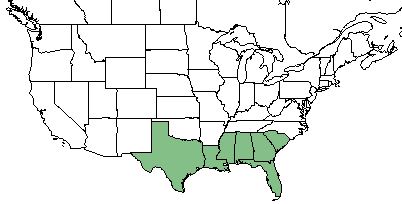Paspalum plicatulum
Common name: brownseed paspalum[1]
| Paspalum plicatulum | |
|---|---|

| |
| Photo by Betty Wargo hosted at Atlas of Florida Plants | |
| Scientific classification | |
| Kingdom: | Plantae |
| Division: | Magnoliophyta - Flowering plants |
| Class: | Liliopsida - Moncots |
| Order: | Poales |
| Family: | Poaceae |
| Genus: | Paspalum |
| Species: | P. plicatulum |
| Binomial name | |
| Paspalum plicatulum Michx. | |

| |
| Natural range of Paspalum plicatulum from USDA NRCS Plants Database. | |
Contents
Taxonomic Notes
Synonyms: none[2]
Varieties: none[2]
Description
P. plicatulum is a cespitose, perennial graminoid of the Poaceae family native to North America, Puerto Rico, and the U.S. Virgin Islands.[1] The culms are 4-7 dm tall with glabrous nodes and internodes. The blades are 15 cm long, 1-4 mm wide, usually involute, glabrous on both surfaces, and basally pilose. The sheaths are glabrous, have scarious margins, and 2 mm long ligules. There are 2-3 racemes that are racemose, ascending, and 3-5 cm long. The rachis wing is scaberulous and 1 mm wide. Spikelets are ellipsoid, obtuse, 2.5-2.8 mm long, and grow in 2 rows with 2 abortive rows.[3]
Distribution
P. plicatulum is found along the southeastern coast of the United States from Texas to South Carolina, as well as Puerto Rico and the U.S. Virgin Islands.[1]
Ecology
Habitat
P. plicatulum proliferates in pine savannas and fields.[2] Specimens have been collected from sandhill communities, sand-oak woodlands, pine flatwoods, swamp clearings, full sun woodlands, pine flatwoods, lakeshores, roadside shoulders, savannas, longleaf pine forests, riverbanks, floodplains, wiregrass sandhills, and grassy clearing with loamy sands.[4]
Phenology
P. plicatulum has been observed flowering in May through July.[5]
Fire ecology
P. plicatulum is not fire resistant, but has medium fire tolerance[1]; despite this, populations have been known to persist through repeated annual burning.[6][7]
Herbivory and toxicology
P. plicatulum has high palatability for browsing and grazing animals.[1] This species functions as forage for cattle in the late summer and winter, and is heavily grazed along ditches and wet sites.[8]
Conservation, cultivation, and restoration
Cultural use
Photo Gallery
References and notes
- ↑ 1.0 1.1 1.2 1.3 1.4 USDA Plant Database https://plants.usda.gov/core/profile?symbol=PAPL3
- ↑ 2.0 2.1 2.2 Weakley, A.S. 2020. Flora of the Southeastern United States. Edition of 20 October 2020. University of North Carolina at Chapel Hill, Chapel Hill, North Carolina.
- ↑ Radford, A. E., Ahles, H. E., & Bell, C. R. (1968). Manual of the vascular flora of the Carolinas. Chapel Hill: University of North Carolina Press.
- ↑ URL: http://herbarium.bio.fsu.edu. Last accessed: June 2018. Collectors: Cecil Slaughter, Marc Minno, Loran C. Anderson, Jake Gruis, R.K. Godfrey, Angus Gholson, R.F> Doren, H. Kurz, Wilson Baker, Sidney McDaniel,R.A. Pursell, R. Kral, J.B. McFarlin, R.E. Perue, R. Komarek, Kurt Blum, Ed Tyson, J.S. McCorkle, J. Dwyer, H. Loftin, William Stimson, J.A. Duke, R>L. Lazor, A.F. Clewell, Annie Schmidt, Ann Johnson, John Kunzer. States and counties: Florida (Clay, Leon, Orange, Calhoun, Gadsden, Wakulla, Franklin, Washington, Walton, Jackson, Santa Rosa, Liberty, Union, Nassau, Levy, Citrus, Holmes, Lee, Gulf) Alabama (Crenshaw) Georgia (Grady, Thomas)
- ↑ Nelson, G. PanFlora: Plant data for the eastern United States with emphasis on the Southeastern Coastal Plains, Florida, and the Florida Panhandle. www.gilnelson.com/PanFlora/ Accessed: 24 MAY 2018
- ↑ Glitzenstein, J. S., D. R. Streng, R. E. Masters, K. M. Robertson and S. M. Hermann 2012. Fire-frequency effects on vegetation in north Florida pinelands: Another look at the long-term Stoddard Fire Research Plots at Tall Timbers Research Station. Forest Ecology and Management 264: 197-209.
- ↑ Platt, W.J., R. Carter, G. Nelson, W. Baker, S. Hermann, J. Kane, L. Anderson, M. Smith, K. Robertson. 2021. Unpublished species list of Wade Tract old-growth longleaf pine savanna, Thomasville, Georgia.
- ↑ Byrd, Nathan A. (1980). "Forestland Grazing: A Guide For Service Foresters In The South." U.S. Department of Agriculture.